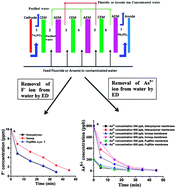Efficacy of polyethylene Interpolymer membranes for fluoride and arsenic ion removal during desalination of water via electrodialysis†
Abstract
Herein, we report the comparative fluoride and arsenic ion removal efficacies of three different pairs of ion exchange membranes viz. indigenously developed polyethylene Interpolymer based ion-exchange membranes, commercial Ionsep and Fujifilm type I membranes during desalination via the electrodialysis process. Different experiments were conducted in a domestic electrodialysis unit (effective membrane area of 20 cm × 10 cm) using 30 pairs of each type of membrane pair. Both the Interpolymer and commercial Fujifilm type I membranes could effectively reduce the fluoride concentration (14.4 ppm) present in ground water of Rajasthan, India to a drinking water permissible limit (<1.5 ppm). The commercial Ionsep membrane could not reduce such a high concentration of fluoride ion to a permissible limit of drinking water. This is attributed to the moderate water uptake and high fluoride ion transport number of the Interpolymer and commercial Fujifilm type I membranes compared to that of the Ionsep membrane. All three different types of ion-exchange membranes could effectively reduce arsenate ion concentrations of 800 ppb (the maximum concentration present in Indian water) to a permissible limit for drinking water (∼10 ppb). The ion removal efficacy of the membranes depends on the concentration of both the fluoride and arsenate ions present in salt water.


 Please wait while we load your content...
Please wait while we load your content...